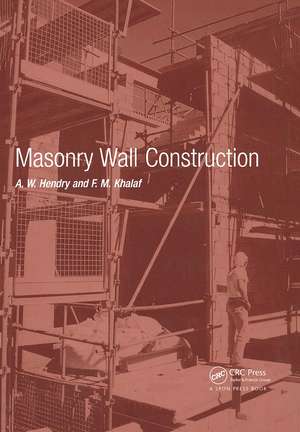Masonry Wall Construction
Autor A. W. Hendry, F. M. Khalafen Limba Engleză Paperback – 28 sep 2000
Preț: 775.35 lei
Preț vechi: 945.55 lei
-18% Nou
Puncte Express: 1163
Preț estimativ în valută:
148.38€ • 153.08$ • 125.58£
148.38€ • 153.08$ • 125.58£
Carte tipărită la comandă
Livrare economică 04-18 martie
Preluare comenzi: 021 569.72.76
Specificații
ISBN-13: 9780415232821
ISBN-10: 0415232821
Pagini: 126
Dimensiuni: 178 x 254 x 7 mm
Greutate: 0.25 kg
Ediția:1
Editura: CRC Press
Colecția CRC Press
ISBN-10: 0415232821
Pagini: 126
Dimensiuni: 178 x 254 x 7 mm
Greutate: 0.25 kg
Ediția:1
Editura: CRC Press
Colecția CRC Press
Public țintă
Postgraduate, Professional, and UndergraduateCuprins
Chapter 1: Introduction. 1.1 Historical perspective 1.2 Applications of masonry wall construction 1.3 Advantages of masonry construction 1.4 Factors affecting the design of masonry buildings 1.5 Future trends. Chapter 2: Masonry Units: Bricks, Blocks and Natural Stone. 2.1 Masonry Units: general 2.2 Manufacture of Units - Clay bricks and blocks; Calcium silicate bricks and blocks; Concrete bricks and blocks 2.3 Properties of bricks and blocks - Physical properties; Mechanical properties 2.4 Natural Stone - General; Granite; Limestone; Sandstone. Chapter 3: Mortar and Other Components 3.1 Mortar - General; Cements for mortar; Sands for mortars; Water for mortars; Admixtures used in mortar; Mortar mix design 3.2 Components - Damp proof course material and cavity trays; wall ties and fixings; Reinforcement. Chapter 4: Structural Design. 4.1 General considerations 4.2 Loading on walls 4.3 Design for compressive loading - Compressive strength of masonry; Allowance for eccentricity and slenderness; Loadbearing capacity of walls 4.4 Resistance of walls to in-plane horizontal loading 4.5 Laterally loaded walls and panels 4.6 Reinforced and prestressed masonry. Chapter 5: Non-Structural Aspects of Design. 5.1 Design for movement - Causes of movement in masonry buildings; Methods of accommodating movement 5.2 Moisture exclusion 5.3 Durability of masonry structures - General; Resistance to frost action; Salt crystallisation and sulphate attack; Atmospheric pollution; Attack by biological agencies; Durability of metal components embedded in masonry 5.4 Thermal design - General principles; Thermal insulation; Condensation 5.5 Acoustic properties 5.6 Fire resistance. Chapter 6: Masonry Wall Construction. 6.1 Types of masonry walls - General; Single leaf walls; Cavity walls; Bonded brickwork walls; Special types of walls; Stone masonry walls 6.2 Masonry construction - General; Current site procedures 6.3 Developments in masonry construction - Prefabrication; Alternative units; Site practice; masonry building systems; Concluding comment. Chapter 7: Defects in Masonry Walls. 7.1 General 7.2 Cracking in masonry buildings 7.3 Rain and damp penetration 7.4 Other visible defects 7.5 Workmanship factors affecting strength. Chapter 8: Repairs and Improvements to Masonry Walls. 8.1 Maintenance and repair - Pointing; Non-structural repairs; Structural repairs 8.2 Improvements and alterations - Waterproofing and basements; Formation of openings in walls; Improvement of thermal insulation; Improvement of acoustic insulation.
Notă biografică
A.W. Hendry was formerly Professor of Civil Engineering at the University of Edinburgh and F.M. Khalaf is at the School of the Built Environment, Napier University.
Recenzii
'This concise volume forms a good introduction to masonry wall construction for the engineering undergraduate and others on construction based courses' - Masonry International
Descriere
This volume provides a concise overview of the main facets of masonry wall construction, including materials, structural design, types of walls, movement, insulation, rain exclusion, site practice, defects and repair. It will also be a useful guide for practising engineers and other professionals who require a general knowledge of masonry construction.










